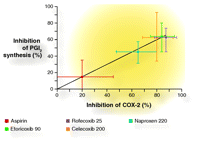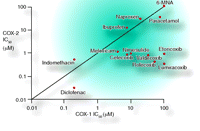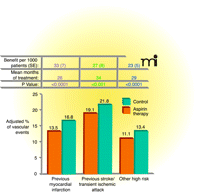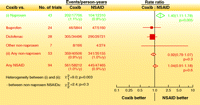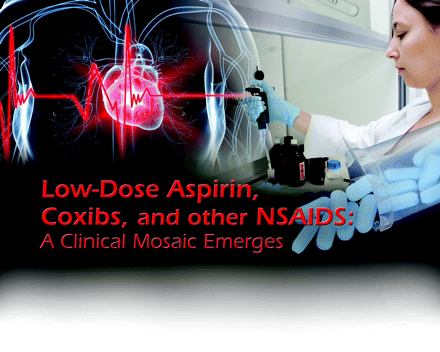Low-Dose Aspirin, Coxibs, and other NSAIDS: A Clinical Mosaic Emerges
Abstract
Aspirin has been a commercial drug for over a century, although for most of this history, an understanding of its mechanism of action, as an inhibitor of cyclooxygenase (COX) activity and thus of prostanoid synthesis, was lacking. Over the past fifty years, a large number of other nonsteroidal antiinflammatory drugs (NSAIDs) have been developed, and a much deeper understanding of inflammation and prostanoid action has emerged. Indeed, a new class of selective inhibitors of the cyclooxygenase-2 isozyme was introduced, about ten years ago, and these so-called coxibs quickly became regarded as preferable, in certain clinical contexts, to avoid side effects associated with the use of traditional NSAIDs. This regard for coxibs has been challenged by the unraveling of a previously unknown cardiotoxicity associated with COX-2 inhibition. Here, we discuss the mechanisms underlying the cardiovascular effects of low-dose aspirin, traditional NSAIDs, and coxibs, and we attempt to reconcile the human pharmacology of COX isozyme inhibition with the contrasting cardiovascular phenotypes that have emerged from randomized clinical trials.
Introduction
Aspirin has been on the market for 110 years. Beginning with the marketing of indomethacin for the treatment of rheumatoid arthritis in 1963, over twenty other nonsteroidal antiinflammatory drugs (NSAIDs) with aspirin-like actions have been developed over the past half century (1), culminating with the introduction of a new class of selective inhibitors of cyclooxygenase (COX)-2, the coxibs, about ten years ago (2). The NSAIDs probably represent the single most crowded category of pharmacological agents that share the same therapeutic activities and mechanism of action. This may reflect the unmet therapeutic need in the area of pain and musculoskeletal disorders as well as the substantial interindividual variability in response to these agents.
Although nuances in tolerability of various NSAIDs had been described in the pre-coxib era (based on clinical trials of a few hundred patients treated for up to a few months), important differences in safety were subsequently demonstrated in head-to-head randomized comparisons of individual coxibs and one or more traditional NSAIDs; these comparisons were based on clinical trials of tens of thousands of patients treated for up to a few years. Moreover, the potential for a novel indication in the chemoprevention of colorectal cancer led for the first time to the design of many long-term (three to five years), placebo-controlled, randomized trials of celecoxib and rofecoxib in several thousand patients with sporadic colorectal adenoma.
As a result of these more extensive trials, new light has been shed on the whole field of NSAID research during the past decade. The coxib trials added to information provided by epidemiological studies that had previously associated regular use of NSAIDs with certain aspects of vascular toxicity, such as increased blood pressure and enhanced risk of congestive heart failure (3), and ascribed an increased risk of atherothrombotic vascular events to COX-2 inhibition (4). This risk was largely unexpected and paradoxical, given that aspirin, the prototypic COX inhibitor, had been clearly shown to be cardioprotective, over a wide range of doses, up to 1,500 mg daily (5). Here, we will discuss the mechanisms underlying the cardiovascular effects of low-dose aspirin, traditional NSAIDs, and coxibs, and we will attempt to reconcile the pharmacology of COX isozyme inhibition with the contrasting results that have emerged from clinical trials.
Arachidonate Metabolism in Platelets and Endothelium
The stimulation of platelet aggregation, by various agonists, leads to the activation of membrane phospholipases and consequent release of arachidonic acid; the enzymatic cyclooxygenation of arachidonic acid, in turn, produces the prostaglandin (PG) endoperoxides PGG2 and PGH2. PGH2 is metabolized by thromboxane (TX)-synthase (the most abundant isomerase in human platelets) to form TXA2 as the predominant platelet prostanoid. In mature platelets, this rapid chain of metabolic events is initiated by cyclooxygenase 1 (COX-1), whereas transient expression of COX-2 appears to be restricted to newly formed platelets (6). Prostanoids are not generally required to produce a functional response, but rather serve to modulate its intensity and duration. For example, human platelets will aggregate and form a hemostatic plug in response to thrombin even if TXA2 is absent; however, the synthesis and release of TXA2—by virtue of its interaction with the platelet TP receptor (7)—provide an important mechanism for the amplification of an activation signal (e.g., exposure to thrombin). The COX-1–dependent generation of TXA2 thus initiates an amplification loop that propagates and sustains agonist signaling among platelets.
Upon platelet activation, rates of TXA2 synthesis and release can increase by three orders of magnitude relative to the resting state, and this metabolic output is largely driven by enhanced substrate availability (7). Indeed, the maximal biosynthetic capacity of human thrombin-activated platelets to produce TXA2 in vitro (300–400 ng/ml of whole blood in one hour) exceeds the basal rate of TXA2 biosynthesis in vivo (0.1 ng/kg/min) by a factor of several thousand (8). The remarkable ability of platelets to increase their production of TXA2, by virtue of an explosive chain reaction, may explain, at least in part, the unusual requirement for virtually complete pharmacological suppression of platelet COX-1 activity in order to impair platelet activation in vivo (Figure 1⇓) (9, 10).
Assessing the relationship between inhibition of platelet COX-1 activity and thromboxane biosynthesis in man. In human platelets (left), the maximal capacity for COX-dependent prostanoid synthesis ex vivo (here, measured as TXB2 produced during whole blood clotting) is three orders of magnitude greater than the basal in vivo biosynthetic rate of thromboxane (middle panel, calculated according to excretion of liver-metabolized products in urine; designated as 11-dehydro-TXB2 & other metabolites). Following aspirin administration, the relationship between inhibition of platelet cyclooxygenase activity measured ex vivo (serum TXB2), and inhibition of thromboxane biosynthesis in vivo (urinary 11-dehydro-TXB2) is non-linear, with substantial inhibition of the latter only occurring at complete suppression of the former (right panel). [ See (8, 10) and references therein.]
The major product from the COX-catalyzed metabolism of arachidonic acid in human macrovascular endothelium is prostacyclin [(PGI2); approximately 20 ng can be produced per 106 arachidonate-stimulated endothelial cells in culture] (11). PGI2 is a vasodilator as well as a potent inhibitor of platelet aggregation. Its basal rate of entry into the systemic circulation is as low as that of TXA2 [approximately 0.1 ng/kg/min in healthy subjects (12)], resulting in circulating levels that are at least tenfold lower than the minimal amount that inhibits platelet function. However, the in vivo biosynthesis of PGI2, as reflected by PGI2 metabolite (PGI-M) excretion, is enhanced in clinical syndromes of platelet activation (13), suggesting that it functions to mitigate accelerated platelet–vessel wall interactions.
The pathophysiological relevance of PGI2 has been a subject of dispute during the past thirty years. Moncada and Vane, in 1979, proposed that vascular homeostasis is determined by a balance between the platelet production of TXA2 and the endothelial production of PGI2, and that the occurrence of thrombotic disorders is influenced by factors that alter this balance (14). Lack of specific inhibitors of PGI2 synthesis, or inhibitors of PGI2 action, to test this hypothesis eventually led to a less enthusiastic view of its role in vascular homeostasis, as exemplified by Majerus’s editorial perspective (15) in 1983: “In summary, the importance of PGI2 in thrombo-resistance has probably been overemphasized. There is currently no evidence that inhibition of PGI2 production is an undesirable side effect of pharmacological inhibition of thromboxane A2 production.” Indeed, the hypothesis put forward by Moncada and Vane would have to wait another twenty years or so to be tested, when the results of large post-marketing coxib trials and mice deficient in the PGI2 receptor (IP) became available (16). The latter approach allowed for the first demonstration that PGI2 modulates platelet-vascular interactions in vivo and specifically limits the cardiovascular response to TXA2 (17). The use of selective COX-2 inhibitors, which reduce PGI-M excretion by sixty to eighty percent, suggests that PGI2 biosynthesis is largely a COX-2–driven process in humans (18–20). Nevertheless, the hypothesis that COX-2 is normally expressed by endothelial cells in response to the physical shear stress of blood flow (21) remains disputed (22).
As compared to platelets, human endothelial cells have a considerably lower biosynthetic capacity to generate prostanoids. Although the maximal biosynthetic capacity of endothelial cells cannot be assessed ex vivo, one can examine the LPS-induced expression of COX-2 in circulating monocytes (23) to assess systemic effects of COX-2 inhibitors. Paired measurements of inhibition of monocyte COX-2 activity, as assessed ex vivo, and inhibition of PGI-M excretion, as assessed in vivo, are consistent with a linear relationship between the two (Figure 2⇓) (24). The apparent discrepancy between the requirements for inhibition of TXA2 biosynthesis as compared to PGI2 biosynthesis have important implications for the interpretation of the cardiovascular effects of different classes of COX inhibitors. Platelet and vascular responses to a PGI2 analog, as well as time to thrombotic carotid arterial occlusion, are modulated by IP deletion in a dose-dependent fashion (25), supporting a linear relationship between inhibition of PGI2-evoked signaling and PGI2-mediated functional effects.
Assessing the relationship between inhibition of COX-2 activity and prostacyclin biosynthesis in man. Systemic inhibition of COX-2 activity was determined as inhibition of LPS-induced PGE2 production in whole blood ex vivo, and inhibition of prostacyclin production was determined as reduced urinary excretion of of 2,3-dinor-6-keto-PGF1α, a major enzymatic metabolite of prostacyclin. In response to the administration of five different COX inhibitors, the relationship between inhibition of COX-2 activity and inhibition of prostacyclin biosynthesis was linear, with substantial inhibition of the latter occurring at levels of incomplete suppression of the former. [Reproduced from (24) with permission from the American College of Cardiology.]
Clinical Pharmacology of COX Isozyme Inhibition
Low-dose aspirin, by virtue of its short half-life and its irreversible inactivation of COX, provides a paradigm of COX-isozyme–selective and cell-specific inhibition in vivo (26). The relative selectivity of low-dose aspirin for COX-1 arises from both pharmacokinetic determinants, such as the acetylation of platelet COX-1 that occurs in portal blood prior to first-pass metabolism (27), and pharmacodynamic determinants, such as the cumulative nature of platelet COX-1 inactivation upon repeated daily dosing (28, 29). Thus, a 30-mg dose of aspirin daily results in virtually complete suppression of platelet TXA2 production after one week (28). There is no evidence that the pharmacodynamics of platelet inhibition by aspirin is any different in women than in men (26).
The cumulative nature of platelet COX-1 inactivation by repeated low doses of aspirin (28) shifts the dose–response relationship by a factor that is proportional to the daily platelet turnover (29), resulting in saturation of the antiplatelet effect at doses as low as 30 mg daily. The unique pharmacodynamics of the antiplatelet effect of aspirin can be readily aligned with important clinical observations: i) virtually complete inhibition of platelet TXA2 biosynthesis in the vast majority of subjects who take the drug regularly; ii) the persistence of this effect over the 24-hour dosing interval in the vast majority of subjects with an 8–10 day platelet life-span; and iii) the efficacy of doses as low as 30–50 mg daily in high-risk patients (26). Other NSAIDs lack these pharmacokinetic and pharmacodynamic features and do not usually achieve the same degree of persistent platelet COX-1 inhibition as is obtained with low-dose aspirin (26).
The selectivity of a particular COX inhibitor is critically dependent on its concentration. One can describe the selectivity profile of different COX-2 inhibitors by plotting the drug concentrations required to inhibit the activity of human platelet COX-1 as a function of the concentration required for fifty-percent inhibition of human monocyte COX-2 (IC50) using widely accepted whole blood assays (Figure 3⇓) (23). This type of analysis establishes two important facts: i) COX-2 selectivity is a continuous variable that does not justify a dichotomous definition of selective and nonselective inhibitors; and ii) there is substantial overlap in COX-2 selectivity among certain coxibs (e.g., celecoxib) and certain traditional NSAIDs (e.g., nimesulide and diclofenac) (2).
Selectivity of various drugs with regard to inhibition of COX-1 and COX-2. IC50 values represent the mean of three or four determinations in whole blood assays. Drugs that appear below the diagonal line indicate preference for COX-2 inhibition over COX-1 inhibition. 6-MNA denotes 6-methoxy-2-naphthylacetic acid, the active metabolite of nabumetone. Updated from (2).
Among patients who receive a standard dose of a given COX-2 inhibitor, there will be substantial interindividual variability in the ensuing plasma concentration, and the extent of COX-isozyme inhibition will similarly vary at any given plasma concentration. For pragmatic purposes, one can distinguish three levels of COX-2 selectivity according to the probability of sparing platelet (and presumably, gastrointestinal mucosa) COX-1 at therapeutic plasma levels: low selectivity (e.g., acetaminophen); intermediate selectivity (e.g., celecoxib, nimesulide, and diclofenac); and high selectivity (e.g., rofecoxib, etoricoxib, and lumiracoxib). Nevertheless, the classification of “selectivity” should be regarded as relative rather than absolute; a two- to fourfold increase in the daily dose of a COX-2 inhibitor with intermediate selectivity may increase the rate of COX-1–dependent complications (e.g., upper gastrointestinal bleeding) up to a rate typical of traditional NSAIDs at standard dosing. Factors that can potentially contribute to the variability of clinical COX-2–dependent effects include the daily dose of the inhibitor that is administered (influencing the extent of COX-2 inhibition), the half-life and dosing interval (influencing the duration of COX-2 inhibition), and the patient substrate. Because the negative vascular consequences of endothelial COX-2 inhibition appear to be attenuated by profound and persistent blockade of platelet COX-1 activity (25), the cardiovascular effects associated with most traditional NSAIDs are more likely to resemble the pro-thrombotic effects of coxib use than they are the anti-thrombotic effects of aspirin.
In addition to being influenced by daily dose, half-life, duration of treatment, and COX-2 selectivity, which are all continuous variables that could influence the cardiovascular outcome of COX-2 inhibition, clinical findings are also a function of the non-linear relationship between the inhibition of platelet COX-1 activity and down-regulation of TXA2-dependent platelet activation (Figure 1⇑). Thus, whether platelet COX-1 activity is inhibited by zero to twenty percent (as typically achieved with highly selective COX-2 inhibitors), or by twenty to fifty percent (as typically achieved with COX-2 inhibitors endowed with moderate COX-2 selectivity), or by fifty to ninety percent (as typically achieved with most traditional NSAIDs), the suppression of TXA2 biosynthesis will be negligible in vivo. Naproxen, when given regularly at high doses and an adequate dosing interval (i.e., 500 mg bid), is the only traditional NSAID that has been reported to inhibit platelet COX-1 activity by greater than ninety percent throughout the dosing interval and to suppress TXA2 biosynthesis in vivo to the same extent as low-dose aspirin (30, 31).
Clinical Cardiovascular Phenotypes of COX Inhibition
As summarized in Table 1⇓, the cardiovascular phenotypes of COX inhibition in humans range from cardioprotection to cardiotoxicity. When evaluating rates of cardiovascular events potentially related to COX inhibition (e.g., myocardial infarction, stroke, or vascular death), one must keep in mind the low incidence of such outcomes in the general population. In the case of myocardial infarction, for example, the incidence is one to four occurences per 1,000 patient–years (3); moreover, only a small fraction of these events are likely to be COX-dependent. Thus, the signal-to-noise ratio of the measurements made in clinical studies is often less than ideal. Because of these caveats, we will focus our review of the clinical evidence primarily upon the results of meta-analyses of randomized trials that avoid placing undue emphasis on the results of individual studies.
Clinical Cardiovascular Phenotypes of COX-Isozyme Inhibition
A very large database of randomized clinical trials offers compelling evidence that the prevention of myocardial infarction and ischemic stroke by aspirin is largely the result of permanent inactivation of platelet COX-1 (5, 26). These studies, testing the efficacy and safety of daily doses ranging from 30 mg to 1,500 mg, have established two important facts. First, the antithrombotic effect of aspirin is saturable at doses in the range of 75–100 mg, consistent with dose requirements for platelet COX-1 inactivation (5, 26). Second, despite a half-life of approximately 20 minutes in the human circulation, the antithrombotic effect of aspirin is observed at oral dosing intervals of 24–48 hours, reflecting the irreversibility of platelet COX-1 inactivation and the duration of TXA2 suppression (5, 26). Other mechanisms of action that have been proposed for the antithrombotic effect of aspirin, such as an anti-inflammatory effect of the drug, are simply incompatible with these observations (5, 26).
Although the search for the lowest effective dose of aspirin for platelet inhibition was largely driven by the explicit concern of concomitant inhibition of vascular PGI2 production (28, 32), it remains uncertain whether dose-dependent suppression of PGI2 in fact attenuates the antithrombotic effect of high-dose aspirin in clinical syndromes of vascular occlusion. Aspirin is an effective antithrombotic agent over a wide range of doses (33). An updated meta-analysis of eleven randomized clinical trials, comparing aspirin regimens among approximately 9,600 high-risk patients, reveals no statistically significant difference in the effects of aspirin on vascular events between higher (500–1500 mg) and lower (75–325 mg) doses (unpublished data). The efficacy and safety of aspirin as an antithrombotic agent have been evaluated in several populations, including apparently healthy individuals at low risk of vascular complication (i.e., “primary prevention”) as well as high-risk patients presenting with or surviving an acute myocardial infarction or acute ischemic stroke (i.e., “secondary prevention”). Studies have ranged in duration from a few weeks to ten years (5).
In six primary prevention trials, including approximately 95,000 participants and a mean follow-up of 7 years, aspirin allocation reduced the risk of serious vascular events (myocardial infarction, stroke, or vascular death) by approximately one-eighth (34); this protective effect represents primarily a reduction by about one-quarter in the rate of nonfatal myocardial infarction. There was no significant overall effect on stroke and no significant reduction in vascular mortality (34). Each year, within the populations studies, on average, fewer than 1 person in every 1000 without a prior vascular event could expect to avoid an event by adding aspirin to other (safer) forms of primary prevention (e.g., a statin and an ACE inhibitor), whereas a comparably small number could expect to experience a major extracranial bleed.
Among patients with occlusive vascular disease, both individual studies [reviewed in reference (26)] and a meta-analysis of trials of antiplatelet therapy (33) indicate that aspirin reduces the risk of a serious vascular event by approximately one-quarter. This represents a composite of a one-third reduction in nonfatal myocardial infarction, one-quarter reduction in nonfatal stroke, and one-sixth reduction in death from a vascular or unknown cause. Since each of these proportional reductions applies similarly to all categories of patients with vascular disease, the absolute benefits of aspirin in a hypothetical patient can be estimated by applying a one-third reduction to the estimated absolute risk of nonfatal myocardial infarction, a one-quarter reduction to the risk of nonfatal stroke, and a one-sixth reduction to the risk of vascular death (26, 33). Thus, among a wide range of patients with vascular disease studied in the past, in whom the annual risk of a serious vascular event ranged from 4 percent to 8 percent, aspirin typically prevented at least 10 to 20 fatal and nonfatal vascular events for every 1000 patients treated for one year (Figure 4⇓) (26, 33). Although these benefits will be somewhat smaller if aspirin is added to modern forms of secondary prevention, the benefits of aspirin are still likely to exceed the bleeding risks among such patients by a considerable margin (26, 33).
Absolute benefits of antiplatelet therapy with aspirin on serious vascular events (nonfatal myocardial infarction, nonfatal stroke, or death from vascular causes) in different groups of high-risk patients. The size of the absolute benefit is expressed by the number of serious vascular events avoided by long-term (2–3 years) aspirin therapy per 1000 patients. Based on analysis of data from the Antithrombotic Trialists’ Collaboration (33).
Coxibs represent the first class of NSAIDs to be adequately investigated in large, randomized trials. The early detection of a potential cardiotoxic signal in the VIGOR study (35), published in 2000, and the exponential growth of litigation cases following Merck’s voluntary withdrawal of rofexocib from the market in 2004 greatly influenced general opinion. Even within the biomedical community, many came to assume that cardiotoxicity was a problem particular to rofecoxib, somehow unrelated to its inhibitory effects on COX-2. In fact, the cardiotoxic phenotype clearly displayed in the placebo-controlled APPROVe trial (36) was closely reproduced by the results of the APC trial of celecoxib (37), a placebo-controlled study in the same patient population and with similar duration of follow-up as in the APPROVe study.
In the first tabular meta-analysis of coxib trial data (38), we sought to address several considerations: i) the limited reporting of vascular events in coxib trials, since they were not prespecified endpoints; ii) the statistical uncertainty surrounding point estimates of individual trials that range from a modest sixteen-percent increase in cardiovascular risk to an implausible eightfold increase in risk; and iii) the absence of long-term, placebo-controlled studies of traditional NSAIDs. We ascertained that allocation to a coxib (i.e., rofecoxib, celecoxib, valdecoxib, etoricoxib, or lumiracoxib) was associated with a 42% increase in the incidence of serious vascular events (from 0.9% to 1.2% per year) relative to placebo, with no statistically significant heterogeneity among the coxibs studied (38). The increased risk primarily reflected an approximate twofold increased risk of myocardial infarction (from 0.3% to 0.6% per year), with little apparent difference in stroke or vascular death (38). Among trials lasting more than one year (and a mean of 2.7 years), the rate ratio for serious vascular events (1.45) did not differ from that calculated for short-term and long-term trials combined (1.42) (38). The early emergence of cardiotoxic effects associated with COX-2 inhibition, as observed in a two-week valdecoxib/parecoxib trial after cardiac surgery (39), and time-to-event analyses of celecoxib and rofecoxib trials (40, 41), are consistent with the proposed mechanism of action (4). Although it is conceivable that long-term suppression of the atheroprotective role of PGI2 may have additional effects above and beyond the amplification of platelet activation, the amount of data available to test this hypothesis in humans remains inadequate. The available data from placebo-controlled trials are also inadequate to allow assessment of whether the cardiovascular risks of coxibs are dose-dependent. Celecoxib was the only agent to be investigated in a relatively wide range of doses (200–800 mg daily) (38). A patient-level pooled analysis of adjudicated cardiovascular data from approximately 8,000 patients in six placebo-controlled trials of celecoxib with a planned follow-up of at least three years (40) confirms a trend towards larger risks with higher daily doses, as we noted in our meta-analysis of published and unpublished tabular data (38).
Traditional NSAIDs have long been considered to pose no cardiovascular hazard, except for their hemodynamic effects potentially enhancing the risk of congestive heart failure (3). In fact, they were often considered potentially cardioprotective because of their inhibitory effects on platelet COX-1. In our meta-analysis (38), many randomized trials of coxibs included one or two NSAID comparators, most often ibuprofen, diclofenac, or naproxen. The incidence of serious vascular events associated with coxib treatment (1.0% per year) was similar to that associated with traditional NSAIDs (0.9% per year) (38); however, a significant difference in rate ratios was found beween coxib-vs-naproxen (rate ratio, 1.57) and coxib-vs-non–naproxen NSAID (rate ratio, 0.88) comparisons [see (38) for details]. We used statistical methods for indirect comparisons to calculate summary rate ratios for serious vascular events of individual NSAIDs compared with placebo. These calculations yielded a value close to 1.0 for naproxen and close to 1.5 for both ibuprofen and diclofenac (38). The hypothesis that etoricoxib was not inferior to diclofenac in terms of cardiovascular safety was formally tested in the Multinational Etoricoxib and Diclofenac Arthritis Long-term (MEDAL) program (42), the largest randomized comparison of a coxib-vs–traditional NSAID (approximately 35,000 arthritic patients with average treatment duration of eighteen months). The MEDAL program was also the first randomized trial in the NSAID field to assess thrombotic cardiovascular events as the primary endpoint. Analyses based on serious vascular events yielded hazard ratios, close to 1.0, that were constant over time and compatible with the prespecified criterion for non-inferiority (42). We recently updated the meta-analysis of coxib trials to include not only the results of the MEDAL study, but also the Alzheimer’s Disease Anti-Inflammatory Prevention Trial [ADAPT (43)]. As shown in Figure 5⇓, the results corroborate the statistical heterogeneity between coxib-vs-naproxen (yielding a rate ratio virtually identical to that of coxib-vs-placebo) and coxib-vs–non-naproxen NSAID comparisons (now yielding a rate ratio slightly lower than 1.0). Thus, non-naproxen NSAIDs, particularly high-dose diclofenac and high-dose ibuprofen, appear to share the cardiotoxic phenotype associated with coxibs. Given the size of the cardioprotective effect of low-dose aspirin in low-risk trials (see above), the statistical uncertainty surrounding the point estimate of high-dose naproxen does not allow us to discriminate between a neutral and an aspirin-like cardioprotective phenotype.
Comparison between coxibs and traditional NSAIDs in eliciting serious vascular events. Event rate ratios, with 95% confidence intervals, are indicated by a diamond; rate ratios for individual non-naproxen NSAIDs, with 99% confidence intervals, are indicated by a square and horizontal line. Updated from (38) with data from MEDAL (42) and ADAPT (43) trials.
Conclusions
Virtually all human cell types can express both COX-1 and COX-2 under appropriate circumstances, and both isoforms can subserve physiological as well as pathophysiological roles, depending on the particular context of stimulus and cellular response (e.g., down-stream PGH2 isomerases and prostanoid receptors). Whereas the ratio of maximal biosynthetic capacity to basal biosynthetic rate is approximately 5000 in the case of platelet TXA2 production, the ratio with respect to PGI2 production is much lower. These differences may help explain, at least in part, the different requirements for the extent and duration of COX inhibition in platelets and vascular endothelial cells that translate into detectable functional and clinical effects. The development of low-dose aspirin as an antiplatelet agent has been instrumental in characterizing the role of platelet COX-1 in atherothrombosis (7). Similarly, although quite unexpectedly, the development of coxibs as antiinflammatory agents has been instrumental in elucidating the role of endothelial COX-2 in vascular occlusion (4). Because of the differential requirements for the in vivo inhibition of TXA2 as opposed to PGI2 biosynthesis, most traditional NSAIDs tend to share the effects of the coxibs, rather than aspirin, on prostanoid-dependent cardiovascular homeostasis.
Although emphasis has been placed on COX-2 selectivity as an important determinant of cardiovascular risk associated with COX-2 inhibitors (44), and although this concept has been translated into therapeutic recommendations by the American Heart Association (45), the evidence that we have reviewed suggests that any COX-2 inhibitor may increase the risk of major vascular complications (particularly, myocardial infarction), unless platelet COX-1 is profoundly and persistently suppressed in the vast majority of subjects. It is important to emphasize that the clinical trial evidence we have reviewed was obtained primarily in low-risk individuals (annual rate of serious vascular events <1.0%), the vast majority of whom were not being treated with low-dose aspirin. Extrapolating this information to high-risk patients treated with aspirin is inappropriate, first, because we lack randomized evidence in this particular setting, and second, because the cardiovascular effects of any COX inhibitor (including naproxen) will be largely driven, when platelet COX-1 is fully inactivated by low-dose aspirin, by the extent and duration of COX-2 inhibition in the vasculature.
Given the substantial lack of relevant information, it is not surprising that current guidelines and recommendations on the use of NSAIDs (45–48) come to different, sometimes contradictory conclusions, particularly with regard to aspirin-treated patients at high risk of vascular complications. Additional evidence may come from the ongoing Prospective Randomized Evaluation of Celecoxib Integrated Safety vs Ibuprofen or Naproxen (PRECISION) trial of 20,000 high-risk patients. We may also learn much from a meta-analysis of individual participant data from coxib and NSAID trials, in which the balance of cardiovascular and gastrointestinal complications associated with different COX-2 inhibitors will be examined in relation to baseline characteristics, such as cardiovascular risk factors and concomitant use of low-dose aspirin.
Acknowledgments
Carlo Patrono is supported by the European Commission, EICOSANOX Integrated Project 005033. Colin Baigent is supported by the UK Medical Research Council. The expert editorial assistance of Daniela Basilico is gratefully acknowledged.
- © American Society for Pharmacology and Experimental Theraputics 2009
References
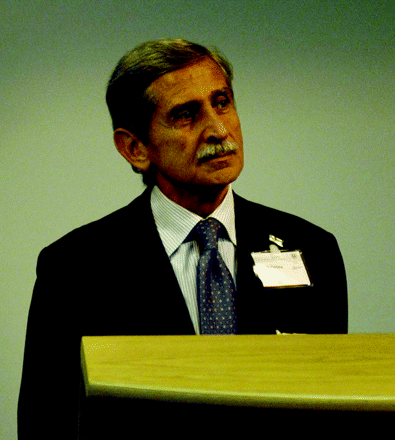
Carlo Patrono, MD, is Professor and Chair of Pharmacology at the Catholic University School of Medicine in Rome, Italy. His main research interest is in the study of platelet activation and inhibition in atherothrombosis. His research has greatly advanced our understanding of the human pharmacology of aspirin as an inhibitor of platelet thromboxane biosynthesis. E-mail carlo.patrono{at}rm.unicatt.it.

Colin Baigent, BM BCh, is Professor of Epidemiology at Oxford. His main research interest is in the design, conduct, and application of randomized trials. He leads a research group that coordinates large scale meta-analyses of randomized trials using individual participant data. He also leads a group involved in designing and coordinating randomized trials in nephrology. In particular, he is chief investigator of the Study of Heart and Renal Protection (SHARP).


